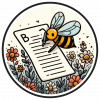Hi All,
I'm working on a project that might require some tech work and as of yet am not a 'tech person' so have been pointed in this direction. It's a pretty common problem that some animals are too small for certain tracking tech; my study species is a lizard SVL 60-90mm, weight 6-11g. RFID came up as an option with studies using tags on very small animals such as wasps - though detection range was limited to around 3cm.
More context; we know very little about the species ecology as they are currently living in remnant, non-native habitat, and cryptic so hard to observe. We'd like to do a semi-wild experimental set-up in the field investigating which native habitat types they might be happy to live in if translocated - probably offering small patches of temporary plantings - and as they're known to spend most of their time below vegetation it's difficult to observe, and fluro-powder tends to get rubbed away/becomes difficult to follow in dense vegetation. Considering setting up some kind of detecting array that could monitor the movements of lizards temporarily fitted (glued) with small RFID tags; issue is largely what tech to go for and how effective it would really be, especially if the range is very limited? Can we just get a big aerial or cable-grid/strips similar to use in fisheries or is the issue all in the tag size? I've had contradictory chats with people about how the tech actually works and what is possible so I'm getting a bit confused...
Any insight welcomed, even if to say we're barking up the wrong tree entirely... thanks!
23 March 2023 6:42pm
Hi Emily,
Signposting a few other convos and resources that might be useful while we wait for some folks to chime in!
Vikram's work might be helpful, he's super lovely and I'm sure he'd be happy to answer questions or speak with you if you think it's a path to go down
If you decide to go down the RFID route, there are quite a few convos if you drop RFID into our search - here's one with lots of advice that might be helpful:
I also swear there was someone in Kate Jone's lab who was popping tiny tags on locusts, @TaliaSpeaker who did that photo belong to?
Steph

Rob Appleby
Wild Spy
24 March 2023 1:06pm
Hi Emily, I think, as you've pointed out, the read range of any tag you use is going to be pretty small. For example, the tags from Sparkfun linked to below have a read range of about 'one inch'. Alternatively, given the weight of your lizards (soooo tiny!) you could potentially consider very small VHF tags like the LB-2X from Holohil. Looking at about 2-3 weeks of battery life, but it would mean you could potentially, more easily track their movements (for example). Happy to discuss and all the best for your research.
Rob
Ultra-Small UHF RFID Tag Rain - 10 Pack
The 'Rain' ultra-small UHF RFID tags from Murata are really exciting because of their fantastically small size -- they're just a 1.25 mm square with a height of 0.55 mm! The tag's tiny composure makes it really well suited to attaching to small or organic

Rob Appleby
Wild Spy
24 March 2023 1:15pm
Hi again Emily,
@tom_august just pointed to this PhD thesis in another post that could be of interest to you also:
All the best,
Rob
Optimising and applying RFID technology to monitor individual honey bee behaviour in agricultural field settings
The western honey bee, Apis mellifera L. is critical for the pollination of numerous native plant species and agricultural crops globally. Although providing a crucial service; honey bee health is currently in decline. One of the most effective methodologies for understanding this decline, is monitoring variation in individual bee behaviour. This thesis presents the development of an optimised radio frequency identification (RFID) system, which is designed for monitoring full-strength colonies in field locations. The potential of this system was subsequently demonstrated through the investigation of bee longevity and behaviour in two important horticultural crops: sweet cherry and hybrid carrot seed. Furthermore, the versatility of this system was demonstrated by using RFID data to explore the relationship between various weather parameters and foraging behaviour.RFID technology has been widely utilised for researching honey bees; however previous studies have predominantly been restricted to small nucleus colonies in semi-field conditions. Application has also been limited by poor detection accuracy and lack of analytical methodologies. To address these issues, a solar powered RFID system was developed and extensively tested for use on full-strength commercial bee colonies (Chapter 2). This included the design of a unique 'maze' entrance that can be retrofitted to any Langstroth hive to enable the accurate detection of bees equipped with RFID tags. The system consists of readily available componentry, which is cost effective and can be purchased off the shelf. Recommendations also include the comparisons of different commercially available RFID tags utilised in previous studies. All facets of RFID design were considered to develop one of the most accurate systems presented to date, with tag detection rates as high as 90.5% for passing bees. Extensive analytical methodology is provided to confirm system accuracy and to facilitate biological understanding. This enables the quantification of key parameters linked to honey bee ontogeny and foraging performance such as: number of flights, flight duration, age at onset of foraging and survival.Modern agricultural production is becoming increasingly reliant on protected cropping systems such as greenhouses, bird netting and polythene tunnels. Although these systems represent distinct advantages for plant growth, little is known about the potential impacts to insect pollinators. To address this, the newly developed RFID system was utilised to investigate the impact of bird netting and two polythene rain cover systems on the behaviour of honey bees in sweet cherry (Prunus avium L.) crops (Chapter 3). Across two seasons, six commercial bee colonies were equipped with RFID systems and over 1300 tagged bees. These colonies were positioned in a neighbouring open field (control), under permanent bird netting or within polythene systems (semi-permanent VOEN system in 2019 and an automated retractable Cravo system in 2020). Individual bee behaviour was subsequently monitored throughout the pollination period to determine the impact of covers on orientation, foraging behaviour and survival. Polythene rain covers (VOEN and Cravo) were found to increase the time required for bees to orientate by 35-45%. However, once orientated, the bees placed under both netted and polythene coverings conducted up to 155% more foraging trips and spent longer outside of the colony. Crop coverings were observed to have limited impact on age of onset of foraging or survival, with all groups transitioning to foraging at an optimal age (mean 15.7-24.1 days) and meeting or exceeding life expectancy (median 19.6-27.5 days). This represents the first study of its kind utilising RFID systems on full size colonies during commercial pollination.Modern agricultural production is also reliant on hybrid vegetable varieties due to key advantages for quality, yield and disease resistance. Despite the agronomic advantages, production of hybrid vegetable seed represents a challenge for pollination due to unattractive floral resources, isolated growing locations and reliance on insecticide applications during crop pollination. The newly developed RFID system was again utilised to investigate the impact of hybrid carrot (Daucus carota L.) seed production on the behaviour of honey bees (Chapter 4). Across two seasons, instrumented colonies were placed in either on-crop or off-crop groups with over 900 bees tagged per season. Differences in bee foraging age and behaviour, over the commercial pollination period, were again compared between groups using RFID data and the collection of pollen pellets and nectar foragers. Hybrid carrot crops were found to have a significant impact on honey bee foraging behaviour, with bees on the crop conducting less frequent but longer foraging trips. Substantial variation in behaviour was associated with the poor attractiveness of hybrid carrot floral resources. Although impacting foraging behaviour, there was little evidence to suggest that the hybrid seed crops were detrimental to bee health, with carrot bees orientating successfully, transitioning to foraging 4-5 days later, surviving longer (median 24.3-30.6 days) and collecting 3x more pollen in general, as compared to off-crop groups. However, only 2% of this pollen originated from carrot. This represented the first direct investigation into individual bee behaviour within hybrid cropping systems.A significant factor impacting bee behaviour and pollination in all environments is weather. The conditions preventing bees from foraging are well understood; however, it is not known how bees adapt their behaviour in response to changes in weather during a foraging trip. In Chapter 5, RFID trip data (1728 trips from 105 bees) in combination with high resolution weather recordings, were used to successfully model the influence of a variety of weather parameters on foraging flight duration. A series of nested linear mixed models revealed that temperature, humidity, solar radiation, barometric pressure and windspeed impacted trip duration. The additional factors of bee age, colony and rainfall were also considered in all models. Barometric pressure was found to be the most effective individual weather variable for modelling trip duration, accounting for 61.2% of variation. However, the most effective model overall, incorporated the minimum, maximum and mean of all-weather variables, accounting for 72.4% of variation in trip duration. This represents a highly complex relationship, with bees perceiving changes in weather and modifying behaviour accordingly.In the final chapter, a synopsis of the experimental findings is provided including recommendations for future research. This thesis presents critical advancements in the methodologies for studying variation in individual bee behaviour. The potential of the newly developed RFID system has been demonstrated in key agricultural environments, generating data with both practical and biological relevance. It is hoped that this can contribute to optimising both bee health and pollination in the future.
22 April 2023 3:14am
Not what you asked for (sorry), but if they are cryptic then a possible first step could be to deploy capacitive sensors everywhere, to get a sense of where they like to hang out and when. I'm thinking of TTP223 touch sensors attached to a data logger.












Stephanie O'Donnell